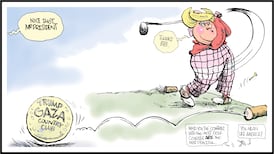Nearly two years ago, the President, Queen Elizabeth and King Albert joined together for the inauguration of the Island of Ireland Peace Park at Messen in Belgium. It was a deeply emotional occasion for all those present, especially for those of us who had long taken an interest in restoring to popular memory the sacrifice and suffering of the hundreds of thousands of Irishmen who served in the Great War of 1914. Finally, it seemed, the Irish State and the Irish people were publicly acknowledging a generation which had been air-brushed from history books and the national narrative of Ireland.
The Army Number One Band and the band of the Royal Irish Regiment, under the baton of that outstanding military musician Commandant Joe Ryan, marched together and played together; and nobody who heard their rousing rendition of "Killaloe" that day will forget it. Nor will anyone who had the great good fortune to hear the President's address in Messen townhall afterwards forget that either - though it is quite beyond me how RTE, the national broadcasting service, failed to record it. No matter; a corner had been turned. Ireland, finally, was at ease with its history, in all its complexity, and the forgotten dead of long ago were now, finally, being honoured.
Dishonoured
Wrong. The dead of long ago are, once again, being dishonoured; and it would have been better if the Memorial Tower of Messen had never been built than it should stand as a monument to neglect of both itself and of those in whose honour it was raised. It is preferable for amnesia and inertia to be invisible than be made flagrant with a park which no-one seems to care about, and which mocks itself with its own declarations.
At the heart of the park is a round tower, with the ground immediately around it divided into four sections, marking the four provinces of Ireland. Each section bears a stone plaque which reads; "These trees symbolise the spirits of (Ulster, Munster, etc.) soldiers marching to the tower and returning home." But there are no trees there. When the park was opened in November 1998, there were indeed trees beside the provincial stone plaques. But they had been hastily planted out of season, and soon died. Three planting seasons have since passed, but no trees have taken their place. Instead of the "trees" which "symbolise" the spirits of the Irish soldiers "marching to the tower and returning home," there is bare, unkempt grass.
Nor is it even a matter of nature being unkind to trees ill-prepared for unseasonal transplanting, or that docks and nettles are flourishing in what were once flower beds. Even the signs in the park boast of human incompetence and official indifference. The central monument was chosen, declares one sign, because round towers predate political and religious divisions in Ireland. "They are easily maintained. They are majestiv and are a symbol of Ireland. It was for these reasons that Round Tower was selected to commemorate all those from the island of Ireland who fought and died."
Numbers
As well as majestiv Round Tower, there is a sign which reads: "As many as 250,000 young men and women left the island of Ireland. As many as 50,000 did not return." Neither figure is correct. We know - because Pat Casey has counted them - how many Irish soldiers died in the Great War - about 35,000, which means that over 300,000 served. It's not difficult to get these little things right.
The Irish Memorial is now on the recommended itinerary of monuments and battlefields in the Ypres area (though fortunately, there were no visitors at all when we were there). Never mind the lack of any official empathy for the sufferings of these men - doesn't a sense of national pride oblige the Government to ensure that the park is kept neat, that the signs are factually and grammatically correct, and that those who arrive there in ignorance of what happened to the thousands of Irish soldiers in the Great War leave better informed and rather impressed by what they find? Or is it preferable to have this huge monument serving as a simple declaration to foreigners that the Irish people can't spell, don't know their history, and can't even properly maintain a single memorial park?
Scores buried
Not far away lies Kemel Cemetery, where scores of Irish soldiers from 1917 are buried, including James Patrick Roche, a Kerry-born barrister who served with the Connaught Rangers as a gunner. He was celebrated as a brilliantly witty raconteur. Whenever he was about to issue one of his quips, a small smile would alight on his face, and would linger when the jest was done. "As a brigade mortar officer," observed his colonel, Rowland Fielding, with soldierly feeling, "a genius."
In the great offensive at Messines in June 1917, which the Memorial Tower commemorates as symbolic of all Irish military endeavours, casualties were relatively light. However, a stray shell massacred a group of Irish officers; and amongst the dead, was Captain James Patrick Roche, MC, a smile still lingering on his face - for he had just heard the greatest joke of all. His parents, Stephen and Elsie Roche, caused to have inscribed on his headstone these words: "An Roisteach Flaitheamhail, Fearamhail nar thug ariamh Eitheach - To The Roche, Generous and Manly Who Uttered No Falsehood." Would that the same could be said about those who promised to maintain this Park, and who have made fools of us all.








